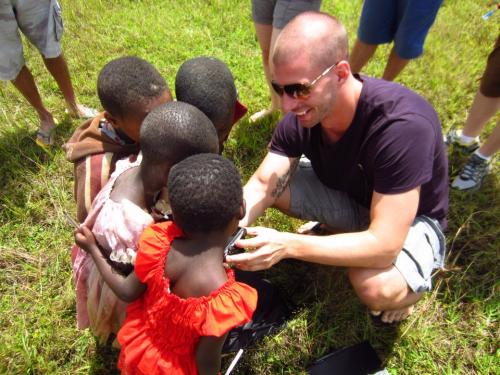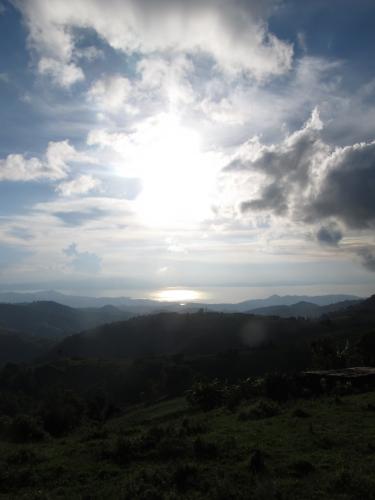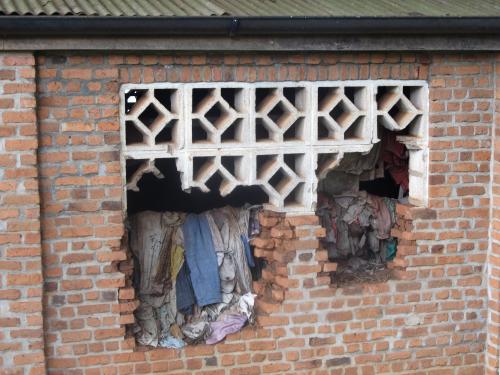Brad Crawford On His Research in Rwanda

He studies conflict in modern Africa and the
Rwandan Genocide. - Susan
Land of a Thousand Lessons:
Reflections on a Tour of Rwanda
By Brad Crawford
Scattered throughout Kigali, the capital and largest city in the small East African nation of Rwanda, are massive billboards that read “Learning from our history to build a bright future.” The billboards evidently refer to the nearly one million Tutsis and Hutu moderates that were slaughtered during the one hundred days of the Rwandan Genocide in the spring of 1994. These billboards most likely lead some to wonder why a nation would promote the worst event in their national history so explicitly. As historians, we often cite “learning from our history to avoid the same mistakes in our future” as one of the main purposes for studying the subject. In Rwanda, this notion is consistently and actively put into practice. (click title to read the whole story)
I toured Rwanda, “Land of a Thousand Hills,” this past May with a small, grassroots NGO called Shout Canada as a member of their “Reflections on Rwanda” program to learn about the history of the 1994 genocide, how the country has addressed the subsequent realities of the atrocity, and its development since. As a Master’s student writing a thesis on the Rwandan Genocide, it was an opportunity that I could not refuse. A group of sixteen students were escorted by four members of the NGO, as well as our invaluable Rwandan guide Faustin Murangwa, a multilingual lawyer, genocide survivor, and truly inspiring human being without whom the program would not function. We toured what felt like the entire country, visiting numerous sites of interest to the program. The more we explored the country and spoke to its people, the more I would note an unsettling dichotomy; the warmth and friendliness that Rwandans consistently displayed both to us and to their fellow countrymen contradicted the stark reality that a genocide of such staggering proportions had occurred in this country less than two decades ago.
The most emotional moments of the trip were not the personal testimonies of victims and the images of human brutality, but rather the testimonies of the rescuers we spoke to. Though the genocide as a whole demonstrated humanity’s capacity for evil, individual stories of sheer bravery, empathy, and will-power during the genocide demonstrated the propensity for selflessness and compassion of which human beings are equally capable.
Speaking to us on the grounds of Nyamata Genocide Memorial, a Catholic church where 10,000 Tutsis were slain, Silas Ntamfura, a former Corporal in the Rwandan military recounted his experience during the genocide. While many of his fellow comrades participated in the genocide, Silas rationalized that as a soldier, he had the power and ability to protect people. Due to what he referred to as his innate “humanism” he believed that if he were able to save a single life, it was his duty to do so. Silas went on to smuggle twenty-five people out of Rwanda and into Burundi by leading them through twenty kilometres of forest using military resources and his own knowhow. His commander discovered what he was doing and ordered his fellow soldiers to shoot him on sight for being a “traitor.” Fortunately, Silas fled to Burundi as a refugee and is now married to one of the Tutsi women he smuggled to safety.
Before departing for Rwanda, I was consistently asked variations of the questions, “Why would you go there?” and “Isn’t it dangerous?” For most, visiting a country that suffered through a genocide and civil war less than twenty years ago was not a good idea. Yet I doubt travelling to the former nations of Yugoslavia today would illicit the same reaction despite that in the last two decades, the Balkan’s have experienced genocide and civil war as well. This reaction was not particularly surprising given the world’s general ignorance of the African continent, whose politics and history are so often generically summarized as if it were a single nation forever locked in a state of conflict and despair. Admittedly, if I were not a graduate student whose field of study was not modern African history, I would know very little of the continents history and politics as well. As it turned out, despite my extensive reading on Rwanda prior to my departure, I too was ignorant of the small, landlocked country. Travelling to the much more visited Tanzania last summer, I expected Rwanda to be much less developed as that nation which receives an endless supply of foreign visitors seeking out world renowned safaris. However, upon walking out of Kigali International Airport and into warm, tropical rains, my eyes were met with a bustling city boasting paved roads, well-maintained public gardens, and glass skyscrapers reminiscent of my own continent. In terms of economic development, it put Arusha, Tanzania’s safari capital and de facto capital of the East Africa Community, to shame. The city had its share of rudimentary buildings, open sewers, dirt roads, and houses unfit for human habitation, but nevertheless, Kigali’s downtown was definitely not what I had envisioned.
After enjoying an excellent dinner on our first night getting to know Faustin and some of his acquaintances, I stepped outside and had what was to be the first of many visually breathtaking Rwandan sights. Standing on the second floor balcony, I had an excellent view of the city and its rolling hills. Given the complete lack of flat land in most of Rwanda, hence its moniker “Land of a Thousand Hills,” houses and businesses often have no choice but to be built upon the slopes of the hillsides. The result was a magnificent twilight view of the city glowing with dots of whitish-blue light, reminiscent of moonlight shining off the ripples of an ocean tide.
Early the next morning, we were at the Kigali Genocide Memorial Centre standing over the mass graves of 250,000 people. To put that number into perspective, it is equivalent to the entire population of Guelph and Waterloo combined. In a twelve hour span we went from enjoying the company of new friends while overlooking a dreamscape, to reflecting on the massacre of hundreds of thousands of human beings, and the gruesome details of how the killers slaughtered their fellow Rwandans with the utmost efficiency. The dichotomy of human kindness and stunning visual landscapes contrasted with humanity’s lowest levels of sadistic capability and all the gruesome visualizations that go along with it, which the memorial sites display overtly, was a common theme of the trip and a consistent topic of debate. The genocide memorials led to a profound question that all students of history should consider; how do you properly commemorate mass atrocities and should you commemorate them at all? The vast majority of memorial sites in Rwanda are places where large massacres occurred. Often, tens of thousands of people were killed in a single location. Anyone who has read books on the genocide knows that a great number of these locations were churches and schools. Tutsis fled to churches with the hope that their faith would protect them from the machetes, clubs, guns, and grenades. This would only make things easier for the murderous bands of Hutu interahamwe militia, and the citizens who joined them, as they murdered both Tutsis and fellow Hutus who refused to join in the slaughter. Tragically, in the years that have passed since the genocide, many priests and ministers have been convicted for aiding the Hutu militia in the slaughter of their own congregations. Faustin’s aunt and uncle were killed in a church whose priest ordered it bulldozed after he rounded everyone inside and locked the door. If there was one thing that the Rwandan Genocide proved, it was that an individual’s religious convictions or lack of them had little bearing on their actions during the atrocity.
What makes Murambi unique is not what happened there but how the site has been commemorated. Roughly 10,000 mummified contorted corpses preserved in lime are displayed in numerous rooms throughout the former school. The overwhelming smell of lime only added to the horrifying sight of the anguished facial expressions of the mummified victims, and that is to say nothing of the room that contained only the corpses of children. It was essentially the physical manifestation of a nightmare. Yet once again, simply stepping outside of one of the rooms and onto the grounds of Murambi and the hilltop on which it is located exposed a panoramic view of lush green hills, blue skies, and the faint sounds of children laughing as they chased goats up the hillsides. Interacting with those children quickly brought me back from the darkness of those rooms and once again the dichotomy of Rwanda was apparent.
The chalk white corpses of Murambi led to an intense debate among the participants of our NGO over the purpose of such overt displays of the horror of the genocide. Is displaying bludgeoned skulls and mummified remains of victims the absolute lowest form of exploitation for the purposes of “dark tourism”? (Photographs inside the memorial sites are not allowed) On the other hand, perhaps the memorial sites and billboards force the citizens of the country to come to terms with the end result of decades of unrestrained government and media indoctrination of hatred, fear, and suspicion of those who belong to not another “tribe” as so often referenced incorrectly, but rather invented ethnic groups legally enforced by European colonial occupiers for the purpose of “divide and rule” and subsequently adopted by Rwandan governments to use as a scapegoat for all the nation’s troubles. I often pondered this question during my time in Rwanda and was unsure of what I felt was the correct answer until reflecting back on the trip as a whole.
One thing that completely caught me off guard was how much I enjoyed Rwanda and would revisit the country solely for a vacation. As we descended down the slopes of a winding dirt road towards the town of Gisenyi located on the Congolese border at the northern tip of Lake Kivu, the volcanic peak of Mount Nyiragongo came into view, glowing a magnificent red against the night sky. Though the Sun had set below the horizon, the sky continued to be illuminated by flashes of silent lightning, without the usual thunder and rain. Lying at the base of the volcano, the twinkle of the border cities of Gisenyi, Rwanda and Goma, Congo came into view on the shore of Lake Kivu. I never knew such breathtaking views existed, especially not in a tiny African nation often forgotten by the rest of the world. We enjoyed a night off from research at a nightclub less than a minute away from the Congo border, where the paved roads turn to mud and the violence of civil war turns from history to reality. I enjoyed one of the best weekends of my life interacting with local Rwandans and Congolese in the nightclub, playing bare-footed soccer with local teenagers, and swimming a fair distance into Lake Kivu towards the Congo in heavy rain. I did not expect so many moments of complete fulfillment and peace in a region ravaged by so much violence and suffering in recent history. The scars of the violence are visible in Rwanda both physically and emotionally. Missing limbs and physical handicaps abound and when reliving their experiences from the genocide, war-hardened eyes begin to water with the memories of those lost. The genocide may be a scar in the Rwandan psyche, but it is one that is healing.
The country has made leaps and bounds in both the social, psychological, and economic development of the country since the genocide. President Paul Kagame, former leader of the Rwandan Patriotic Front which ended the genocide by driving the genocidal Hutu government out of the country, never retaliated against the majority Hutu population and has essentially abolished the Hutu-Tutsi distinction and replaced it with “Rwandan.” There are numerous government organizations and NGOs which serve the population in a variety of ways from truth and reconciliation commissions, genocide education, and support systems for those widowed and orphaned by the genocide. The nation also has an amazing government initiative called “Umuganda”, which occurs on the last Saturday of every month for four hours in the morning. What “Umuganda” entails is the temporary closing of all businesses and traffic in order for every individual to participate in community service, during which everyone helps to clean up their community and skilled professionals may offer their services for free. We participated in “Umuganda” and I must confess that it is not only an extremely cost effective way for maintaining public spaces; but an excellent form of community building.
On the economic front, Rwanda recorded eight percent G.D.P. growth in 2011 and was ranked as the eighth easiest country in the world to start a business by the World Bank. Due to its economic development, it is now dubbed as a “miracle” and draws comparisons to the rapid expansion of the Asian Tigers’ post-WWII development, as mentioned in a recent New York Times article. Unlike many of its African neighbours, the Rwandan government is renowned for reducing corruption, expanding security, and improving women’s rights. Rwanda has the only parliament in the world where women outnumber men. Nevertheless, the nation still has a long way to go. Though Kagame is an elected president who deserves to be credited with much of Rwanda’s post-genocide success, he rules the nation autocratically and political opposition and public dissent are not tolerated. Hopefully, his government will become less repressive and more democratic in the future.
People only ever associate Rwanda with the genocide of 1994 and it is often the only thing people know about the country, a gross oversimplification that neglects the beauty begat by all the horror. Rwanda is a mirror poignantly held up to the face of humanity. It represents at once, the best and worst of what humans are capable of. Most admirably of all, Rwanda provides inspiration. Rwanda represents the ability of humanity to rise from the ashes and persevere. It represents the physical beauty that the Earth possesses. Rwanda represents how a nation and its people can learn from their history, and build a bright future.

